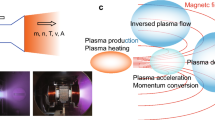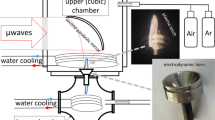Abstract
The structure of electrode microwave (2.45 GHz) discharges in hydrogen with electrodes of various shapes and sizes at pressures of 1–8 torr and incident powers of 2–150 W is studied. It is found that the discharges exhibit a common feature that is independent of the antenna-electrode design: near the electrode surface, there is a thin bright sheath surrounded by a less bright, sharply bounded region, which is usually shaped like a sphere. It is suggested that the structure observed arises because the microwave field maintaining the discharge is strongly nonuniform. Near the electrode, there exists a thin dense plasma sheath with a high electron density gradient. A strong dependence of the electron-impact excitation coefficient on the electric field makes the effect even more pronounced. As the electron density decreases due to dissociative recombination, the microwave field gradient decreases and the discharge emission intensity tends to a nearly constant value. Presumably, in the boundary region of the discharge, there exists a surface wave, which increases the emission intensity at the periphery of the discharge.
Similar content being viewed by others
References
Yu. A. Lebedev, J. Phys. IV (Paris) 8, 369 (1998).
G. M. Batanov, N. K. Berezhetskaya, E. F. Bol’shakov, et al., Plasma Sources Sci. Technol. 2, 164 (1993).
V. G. Brovkin, Yu. F. Kolesnichenko, and D. V. Khmara, in Ball Lightning under Laboratory Conditions (Khimiya, Moscow, 1994), p. 119.
V. G. Brovkin, Yu. F. Kolesnichenko, and D. Khmara, Prikl. Fiz., No. 4, 5 (1994).
L. Bardos, H. Barankova, Yu. A. Lebedev, et al., Diamond Relat. Mater. 6, 224 (1997).
L. Bardosh and Yu. A. Lebedev, Fiz. Plazmy 24, 956 (1998) [Plasma Phys. Rep. 24, 891 (1998)].
L. Bardosh and Yu. A. Lebedev, Zh. Tekh. Fiz. 68 (12), 29 (1998) [Tech. Phys. 43, 1428 (1998)].
O. A. Nerushev, S. A. Novopashin, V. V. Radchenko, et al., Preprint No. 285-97 (Inst. of Thermophysics, Siberian Division, Russian Academy of Sciences, 1997).
S. T. Ivanov, R. W. Thomae, H. Klein, et al., Bulgar. J. Phys. 25, 49 (1998).
V. B. Gil’denburg and G. A. Markov, Pis’ma Zh. Tekh. Fiz. 8 (20), 1245 (1982) [Sov. Tech. Phys. Lett. 8, 535 (1982)].
Yu. A. Lebedev and I. L. Epstein, J. Moscow Phys. Soc. 5, 103 (1995).
L. S. Polak, A. A. Ovsyannikov, D. I. Slovetskii, et al., Theoretical and Applied Plasmochemistry (Nauka, Moscow, 1975).
V. B. Gil’denburg, V. L. Gol’tsman, and V. E. Semenov, Radiofizika 17 (11), 1718 (1974).
V. B. Gil’denburg and V. E. Semenov, Fiz. Plazmy 6, 445 (1980) [Sov. J. Plasma Phys. 6, 244 (1980)].
Author information
Authors and Affiliations
Additional information
__________
Translated from Fizika Plazmy, Vol. 26, No. 3, 2000, pp. 293–298.
Original Russian Text Copyright © 2000 by Lebedev, Mokeev, Tatarinov.
Rights and permissions
About this article
Cite this article
Lebedev, Y.A., Mokeev, M.V. & Tatarinov, A.V. Spatial structure of emission from an electrode microwave discharge in hydrogen. Plasma Phys. Rep. 26, 272–277 (2000). https://doi.org/10.1134/1.952847
Received:
Accepted:
Issue Date:
DOI: https://doi.org/10.1134/1.952847




